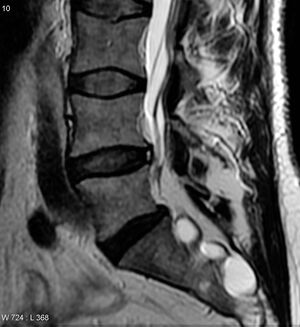Tarlov Cysts
Tarlov cysts also called perineurial or sacral nerve root cysts are are dilations of the nerve root sheaths at the dorsal root ganglion. They manifest as abnormal sacs filled with cerebrospinal fluid. They are extradural but contain neural tissue.
Differentiation
| Tarlov Cyst | Meningeal Diverticula & Arachnoid Diverticula |
|---|---|
| Potential communication with spinal subarachnoid space | Communicates freely with spinal subarachnoid space |
| Found distal to the junction of posterior nerve root and dorsal root ganglion in sacral region | Found proximal to dorsal root ganglion throughout vertebral column |
| Walls contain nerve fibers | Walls lined by arachnoid mater with no signs of neural element |
| Often multiple, extending around the circumference of nerve root | No pattern of formation in regards to multiplicity |
Pathogenesis and Pathophysiology
The pathogenesis can be congenital or acquired.
It can occur due to trauma causing haemorrhage into the subarachnoid space. The accumulation of red cells may impede the drainage of the veins in the perineurium and epineurium, leading to rupture with subsequent cyst formation.
Congenitally it can be caused by arachnoidal proliferations within the root sleeve.
The pathophysiology is thought to be one of a ball-valve mechanism. Cysts are created by the dilated sheaths usually have microconnections to the subarachnoid space. Pulsatile and hydrodynamic forces of CSF cause these cysts to fill and expand in size
Epidemiology
They are seen in up to 4.6% of the population, and are more common in women.[1]
Clinical Features
Most Tarlov cysts are thought to be asymptomatic. It is a controversial matter regarding the prevalence of symptomatic cases. In some causes particularly with large cysts, neurological dysfunction and pain can occur. However symptoms don't correlate very well with the size of the cyst.[2]
Possible symptoms include pelvic or perineal pain, sphincter or sexual dysfunction, radicular pain or radiculopathy, and neurogenic claudication.[3][4]
They are associated with certain connective tissue disorders including Marfan syndrome, Ehlers Danlos Syndrome, Sjogren syndrome, and Loeys-Dietz syndrome.
Imaging
MRI is the imaging study of choice. They are most commonly seen in the lower lumbar spine and sacrum, however they can occur elsewhere in the spine.
They appear as very thin-walled CSF intensity (T1 low signal, T2 high signal) cystic structures that are closely related to the sacral and lower lumbar nerves. The sacral foramina may be widened. Morphology varies from a simple rounded cyst to a more complex loculated cystic mass.[5]
Differentials on imaging include dural ectasia, spinal synovial cyst, meningocele, nerve sheath tumour, and spinal metastases. [5]
On plain films there may be bony erosion of the spinal canal or of the sacral foramina
Treatment
There is no consensus on the optimal treatment of symptomatic sacral perineural cysts. If intervention is considered then the options are aspiration and surgery.
Aspiration
Aspiration can be done under CT guidance using a two-needle technique. Fibrin can be injected to try seal the cyst. Complications include cyst recurrence, CSF leak, infection, and persistent procedural pain.
Surgery
There are various surgical approaches including microfenestration and surgical sleeving of the cysts, +/- biosynthetic dural patch, +/- muscle patch. Cyst excision results in irreversible neural damage.
References
- ↑ Andrieux C, Poglia P, Laudato P. Tarlov Cyst: A diagnostic of exclusion. Int J Surg Case Rep. 2017;39:25-28. doi: 10.1016/j.ijscr.2017.07.045. Epub 2017 Jul 25. PMID: 28787671; PMCID: PMC5545870.
- ↑ Davis SW, Levy LM, LeBihan DJ, Rajan S, Schellinger D. Sacral meningeal cysts: evaluation with MR imaging. Radiology. 1993 May;187(2):445-8. doi: 10.1148/radiology.187.2.8475288. PMID: 8475288.
- ↑ Marino D, Carluccio MA, Di Donato I, Sicurelli F, Chini E, Di Toro Mammarella L, Rossi F, Rubegni A, Federico A. Tarlov cysts: clinical evaluation of an italian cohort of patients. Neurol Sci. 2013 Sep;34(9):1679-82. doi: 10.1007/s10072-013-1321-0. Epub 2013 Feb 12. PMID: 23400656.
- ↑ Hulens Mieke, Bruyninckx Frans, Somers Alix, Stalmans Ingeborg, Peersman Benjamin, Vansant Greet, Ricky Rasschaert, De Mulder Peter, Dankaerts Wim. Electromyography and A Review of the Literature Provide Insights into the Role of Sacral Perineural Cysts in Unexplained Chronic Pelvic, Perineal and Leg Pain Syndromes. (2017) International Journal of Physical Medicine & Rehabilitation. 5 (3): 1. doi:10.4172/2329-9096.1000407
- ↑ 5.0 5.1 Jones, J., Bell, D. Tarlov cyst. Reference article, Radiopaedia.org. (accessed on 14 Feb 2022) https://doi.org/10.53347/rID-10198


